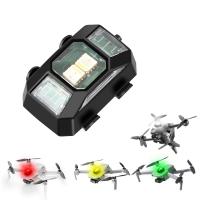How Does A Drone Fly?
Drones, also known as unmanned aerial vehicles (UAVs), have become increasingly popular in various fields, from recreational use to professional applications such as photography, agriculture, and even delivery services. Understanding how a drone flies involves delving into the principles of aerodynamics, the mechanics of its components, and the technology that controls its flight. This article aims to provide a comprehensive overview of these aspects, offering insights into the fascinating world of drone flight.
The Basics of Drone Flight

At its core, a drone flies by generating lift, which counteracts the force of gravity. This lift is produced by the drone's propellers, which spin at high speeds to create a difference in air pressure above and below the blades. The key components that enable a drone to fly include the frame, motors, propellers, electronic speed controllers (ESCs), flight controller, battery, and sensors.
Frame

The frame of a drone is the structural skeleton that holds all the components together. It is typically made from lightweight materials such as carbon fiber or plastic to minimize weight while maintaining strength and durability. The design of the frame can vary, but most drones have a multi-rotor configuration, such as quadcopters (four rotors), hexacopters (six rotors), or octocopters (eight rotors).
Motors and Propellers

The motors and propellers are the primary components responsible for generating lift. Each motor is connected to a propeller, and the number of motors and propellers depends on the drone's configuration. The motors are usually brushless DC motors, which are efficient and provide high torque. The propellers are designed to create thrust by pushing air downwards, which in turn lifts the drone into the air.
Electronic Speed Controllers (ESCs)

ESCs are crucial for controlling the speed of the motors. They receive signals from the flight controller and adjust the motor speed accordingly. This allows the drone to perform various maneuvers, such as ascending, descending, hovering, and changing direction.
Flight Controller
The flight controller is the brain of the drone. It processes input from the pilot (via a remote control or autonomous programming) and data from onboard sensors to maintain stable flight. The flight controller uses algorithms to adjust the speed of each motor, ensuring that the drone remains balanced and responds accurately to commands.
Battery
The battery provides the necessary power to the motors and other electronic components. Most drones use lithium-polymer (LiPo) batteries, which offer a high energy density and are lightweight. The capacity of the battery determines the flight time of the drone, with larger batteries providing longer flight durations.
Sensors
Drones are equipped with various sensors to aid in navigation and stability. Common sensors include accelerometers, gyroscopes, magnetometers, barometers, and GPS modules. These sensors provide real-time data to the flight controller, allowing it to make precise adjustments to maintain stable flight and navigate accurately.
The Principles of Aerodynamics
To understand how a drone flies, it is essential to grasp the basic principles of aerodynamics. Four primary forces act on a drone during flight: lift, weight, thrust, and drag.
Lift
Lift is the upward force that counteracts the weight of the drone. It is generated by the propellers as they spin and push air downwards. The amount of lift produced depends on the speed of the propellers and the design of the blades.
Weight
Weight is the force of gravity acting on the drone, pulling it downwards. The drone must generate enough lift to overcome its weight to achieve and maintain flight.
Thrust
Thrust is the forward force produced by the propellers. By adjusting the speed and direction of the propellers, the drone can move forward, backward, or sideways. Thrust is essential for maneuvering and changing the drone's position in the air.
Drag
Drag is the resistance force that opposes the drone's motion through the air. It is caused by air friction and increases with the drone's speed. Minimizing drag is crucial for efficient flight and longer battery life.
How Drones Achieve Stable Flight
Achieving stable flight involves maintaining a balance between the four forces of aerodynamics and making continuous adjustments based on sensor data. The flight controller plays a vital role in this process by using feedback from the sensors to make real-time corrections.
Hovering
To hover, the drone must generate lift equal to its weight, with no net thrust or drag. The flight controller adjusts the speed of the propellers to maintain this balance, allowing the drone to stay in a fixed position in the air.
Ascending and Descending
To ascend, the drone increases the speed of its propellers, generating more lift than its weight. Conversely, to descend, the drone reduces the propeller speed, producing less lift than its weight. The flight controller manages these adjustments to achieve smooth vertical movement.
Moving Forward, Backward, and Sideways
To move in a specific direction, the drone must create a thrust force in that direction. For example, to move forward, the flight controller increases the speed of the rear propellers while decreasing the speed of the front propellers. This tilts the drone forward, generating thrust in the desired direction. Similar adjustments are made for backward and sideways movement.
Yaw, Pitch, and Roll
Drones can rotate around three axes: yaw (vertical axis), pitch (lateral axis), and roll (longitudinal axis). These rotations allow the drone to change its orientation and direction.
- Yaw: To rotate around the vertical axis, the flight controller adjusts the speed of the propellers in opposite pairs. Increasing the speed of one pair while decreasing the speed of the other pair causes the drone to rotate.
- Pitch: To tilt forward or backward, the flight controller adjusts the speed of the front and rear propellers. Increasing the speed of the rear propellers while decreasing the speed of the front propellers tilts the drone forward, and vice versa.
- Roll: To tilt sideways, the flight controller adjusts the speed of the left and right propellers. Increasing the speed of the left propellers while decreasing the speed of the right propellers tilts the drone to the right, and vice versa.
Advanced Flight Features
Modern drones come equipped with advanced features that enhance their flight capabilities and make them easier to operate.
GPS Navigation
Many drones are equipped with GPS modules that allow for precise positioning and navigation. GPS enables features such as waypoint navigation, where the drone can autonomously follow a pre-defined route, and return-to-home (RTH), where the drone automatically returns to its takeoff point if it loses connection with the remote control or if the battery is low.
Obstacle Avoidance
Advanced drones use sensors such as ultrasonic, infrared, or visual cameras to detect and avoid obstacles in their path. This feature enhances safety and allows for more autonomous flight capabilities.
Follow Me Mode
In Follow Me mode, the drone uses GPS or visual tracking to follow a moving subject, such as a person or vehicle. This feature is popular for capturing dynamic footage in activities like sports and outdoor adventures.
First-Person View (FPV)
FPV allows the pilot to see a live video feed from the drone's camera, providing a first-person perspective of the flight. This feature is essential for applications such as aerial photography, racing, and inspection tasks.
Understanding how a drone flies involves a combination of aerodynamics, mechanical components, and advanced technology. The interplay between lift, weight, thrust, and drag, along with the precise control provided by the flight controller and sensors, allows drones to achieve stable and controlled flight. As technology continues to advance, drones are becoming more capable and accessible, opening up new possibilities for their use in various fields. Whether for recreational enjoyment or professional applications, the principles of drone flight remain a fascinating and essential area of knowledge.



















There are no comments for this blog.